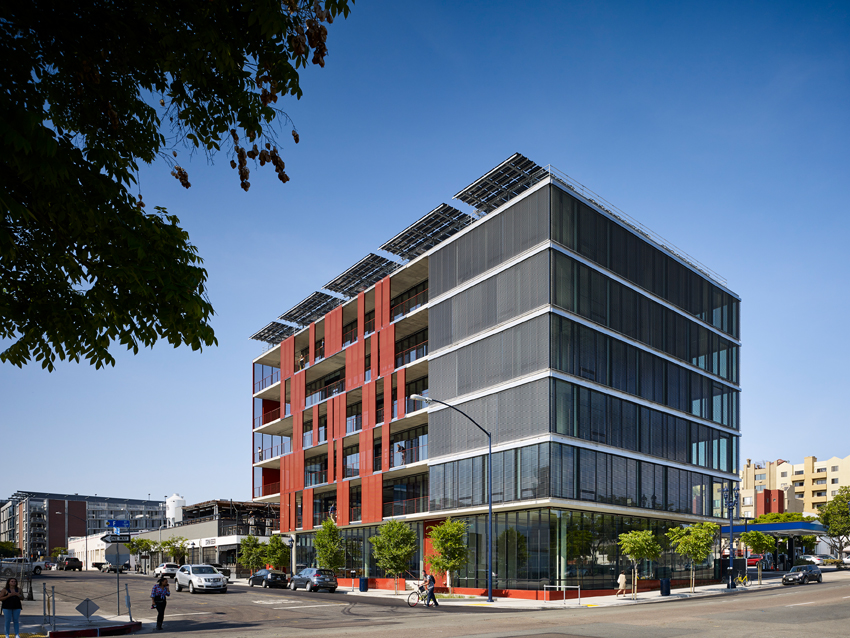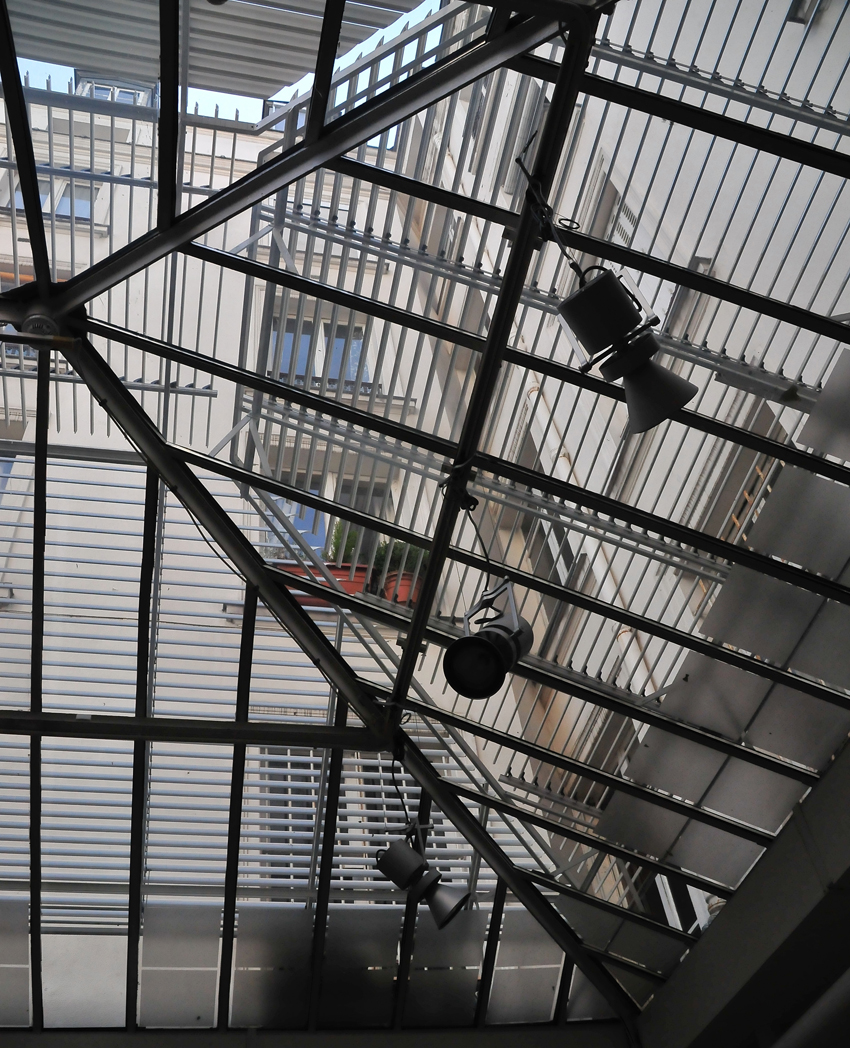Mitigating Glare and Solar Heat Gain with Exterior Shading Systems
In addition to wind, it is also important to protect the blinds from ice. As a result, blinds must retract into a watertight pocket or head box when not in use.
Blind slats can be fully perforated, highway perforated (where the central strip is left unperforated), half perforated, or solid. The most standard openness factors are 3.8 percent, 6 percent, or 9.2 percent.
Perforated slats have the advantage of allowing a view through, even when the blinds are in the closed position. The blinds are generally closed during the early morning or late afternoon when the sun is low in the sky, and set in a horizontal position or partially tilted during most of the day.
Depending upon facade orientation, perforated slats can cause glare, so this must be taken into consideration. Additionally, in comparison to solid slats, perforated slats will add to the cost of the system.
Like zip systems, exterior venetian blinds must be retracted under high wind conditions. The control system will incorporate a wind sensor and when wind gusts exceed 38 miles per hour, the automatic wind-retract system overrides all other controls to ensure that the systems are not deployed when there is a risk of damage through strong winds.
A standard venetian blind is deployed with the slats in the closed position and retracts into an open, horizontal position. Sometimes there are concerns that there will be a sudden loss of light in the building when blinds are deployed and before the slats are tilted to a more open position. To address this, it is also possible to specify the system with a ‘work angle’ setting. In this case, the slats deploy at approximately 35 degrees open, but cannot be tilted to fully closed until the system is completely deployed.
Venetian blind slats tilt through approximately 70 degrees between open and closed. At the 70-degree rotation, there is horizontal cutoff—the bottom of one slat overlaps the top of the one below—that prevents any direct sun penetration while allowing some ambient light into the building. When under automatic operation, it is normal to program three intermediate slat angles, 17.5 degrees, 35.0 degrees, and 52.5 degrees, in addition to the open (horizontal) and closed (70-degree tilted) positions.
Aesthetically, venetian blind systems offer clean lines, pockets/cavity protection, cables or tracks, and a wide range of slat colors. The slats are generally manufactured from aluminum, but wood slats (generally manufactured from western red cedar) are also available.

Photo: Nick Merrick, Hall + Merrick
Exterior venetian blinds offer clean lines and a beautiful aesthetic, as pictured here at Makers Quarter Block D.
“Venetian blinds have seen a resurgence in use for their timeless appearance,” observes Fragali.
Although venetian blinds are most effective in achieving solar control when installed on the exterior, some building owners are hesitant for concerns of durability, maintenance, and adverse weather. Consequently, many opt to install these systems on the interior or in a double facade.
As Noblett has highlighted, it is also possible to consider daylighting blinds where the upper section of the blind is more open than the lower section. The upper section allows more light into the building while the lower section controls light at a work level. Care must be taken with this approach, however, due to the risk of glare issues.
He goes on to say that due to their inherent flexibility and ability to be individually controlled, they are highly suitable for office and institutional environments where individual offices with more discreet window components might be involved. Their unitized nature also makes them more suitable for this kind of repetitive facade module.
As a partner with a firm that has undertaken many projects with exterior venetian blinds, Noblett adds that the systems are a great fit for larger exterior applications. And when the design is well integrated into the building envelope, the impact on the building’s appearance can be minimal.
Rack Arm Systems
Highly versatile, rack arm systems can effectively shade any type, shape, or glazing orientation and provide very effective solar control. In fact, for applications with unique configurations and shapes, rack arms may be the only option for solar control. The system also offers high levels of light exclusion, with the exception of a full blackout, particularly if an interlocking slat is used. Available in a range of sizes, the slats can be opened and closed, but does not retract. Additional applications include facades, rooflights, and pergolas.

Photo courtesy of Draper, Inc.
Rack arm shading systems offer a high level of versatility and can therefore match any type of shape or glazing orientation.
Singing the technology’s praises, Arnold describes rack arm systems as the “Rolls Royce” of exterior sun-shading systems, which can be installed for vertical, horizontal, and inclined applications and offer superior automation options for smart buildings.
“Their main advantage is that they can span larger distances and be used on skylights,” Olsen says. “Like venetian blinds, they allow the louvers to track the sun and block direct sunlight while maintaining view and admitting diffuse daylight.”
“Compared with the other two systems, they are probably the most robust, even if they are designed to articulate based on sun angle,” Noblett adds. “However, they cannot stack like exterior venetian blinds or zip shading, so they always remain in place and part of the view through the glazing.”
The rack arms are installed on the glazing structure and are connected to the operator by a drive shaft. Slats are mounted onto the rack arms, the spacing of which is dependent on the slat size and whether the installation is interior or exterior.
Developed and designed for exterior use, a rack arm system can withstand wind speeds in excess of 100 mph. In exposed locations, the use of baffles to protect the slats around the edge of the system is recommended. It is also recommended to use a wind-control device and that the slats are moved to the open position in strong winds to allow for an equalization of pressure. This reduces slat movement and makes the system much more stable.
Because the rack arm system has a large number of small rotating parts, this makes ice a potential issue, particularly with motorized systems. As a result, the application of rack arms should be carefully considered and in some locations, an interior installation is probably the only realistic option. In many parts of the United States, however, the system is viable as an exterior system.
Control Systems
Operable exterior shading systems do require a control system. As a minimum, the controls must be able to protect the shading device from the wind, and, as noted, systems such as venetian blinds and roller shades will need to be retracted if the wind speed is too high.
Given that exterior systems are designed to control heat gain into the building, they are usually automated, allowing them to respond to the sun conditions. This means that systems will automatically deploy and retract, and the slats of venetian blind systems will adjust between different tilt angles to prevent any direct sun penetration. Because this is the case, it is important that the building users understand the function of the systems and are given initial training about how the systems work, and how they help control the building environment and create good working conditions.

Photo courtesy of Draper, Inc.
Exterior shading with an integrated control system helped DIALOG deliver a net-zero design for the University of Calgary’s MacKimmie Tower.
Where to locate the sensors is an important consideration. For example, solar radiation sensors need to be located with the correct orientation(s) and in a location where they will not be shaded. Wind sensors should be located in a place where they will not be disrupted by other local wind effects, such as from a rooftop penthouse, explains Olsen. “The location of local shade controllers also needs to be identified and specified so that they are in an architecturally acceptable location and reasonably accessible for maintenance,” he instructs.
Another question is whether user interaction is desired and how it will be accomplished. For instance, are users allowed to override and control the shade position, and if so, are the controls being located in a place where they are easy to find and intuitive to use?
Olsen adds some additional questions that must be addressed: Is it aesthetically acceptable to have shades in different positions, controlled by users? Is overheating possible if users are allowed to control the shades, and if so, is this acceptable? If the shades are accessible from the outside, is there any potential for vandalism? Does the shade movement have any impact on an adjacent occupied space?
Noblett brings up an interesting point, which is the fact that while automation is designed to enhance user comfort and optimize building performance, it is not always well received by occupants. “When someone is comfortable and enjoying the state of his or her environment, and some automated building component decides that it is time to alter that environment, this tends to be a source of frustration,” Noblett explains.









